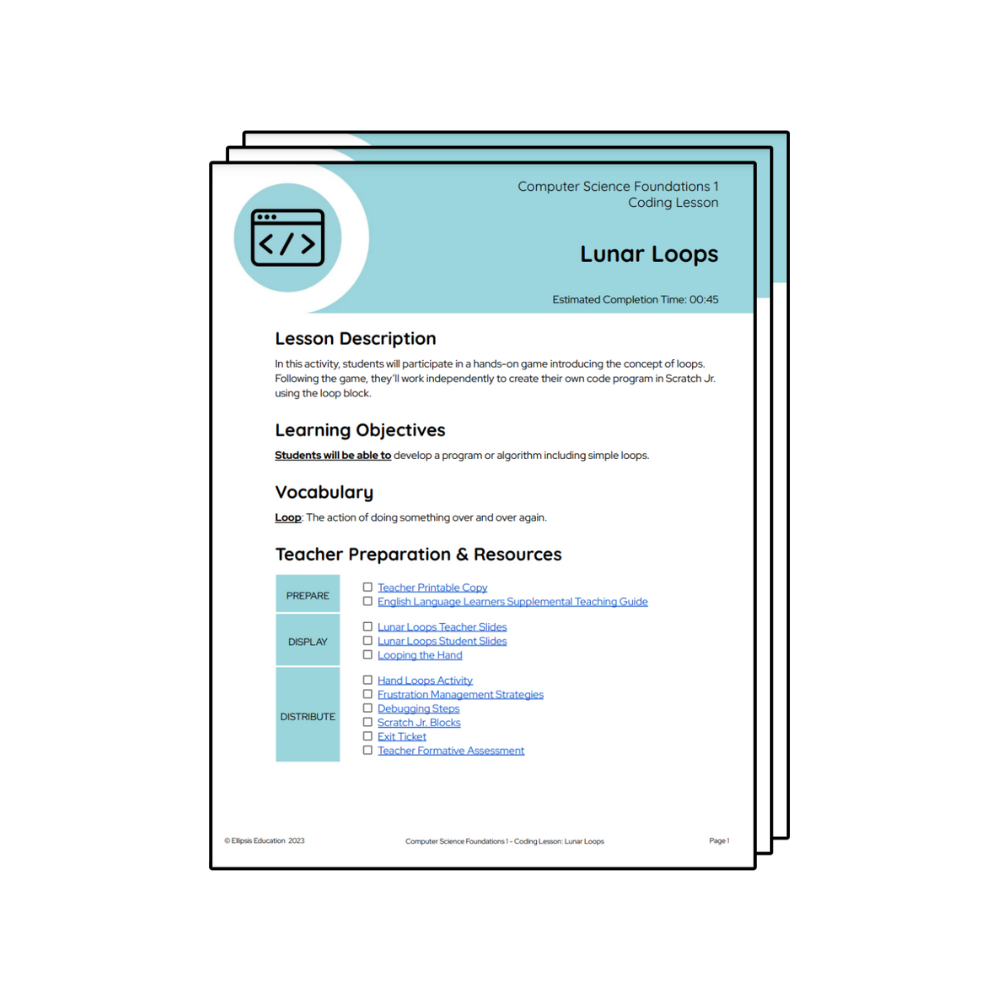Teaching Coding To Elementary Students
As an elementary teacher, you teach every subject: math, science, ELA, and now – coding. Ellipsis Education helps you get started and be effective, regardless of your experience level. That means you can spend less time gathering materials and more time doing what you do best: teaching!
Ellipsis Coding Education Program
Everything in One Place
The Curriculum Delivery Platform houses all your computer science lessons – no more piecing together free resources.
Any Teacher Can Teach
From scripted lesson plans to robust training to continuous learning, Ellipsis helps teachers build confidence and capacity.
Teacher-Led
Just like any reading or math curriculum, Ellipsis leverages your best resource: teachers.
Beyond Coding
Ellipsis lessons develop the attitudes, knowledge, and skills necessary to thrive – in academic settings and beyond.
K-12 Computer Science Curriculum
Our K-12 courses have everything you need to get students going: detailed lesson plans (beyond just coding), pacing guides, standards maps, and ongoing support.
Computer Science Foundations (K-2)
Engage your students with courses that fuel their interest. Coding lessons use ScratchJr, an introductory block coding language, perfect for emergent and early readers.
Computer Science Fundamentals (3-5)
Inspire your students with courses that spark their creativity. Coding lessons use Scratch, a block based coding language, ideal for the transitional and fluent reader.
Computer Science Curriculum Elementary
Download a free lesson plan from Ellipsis Education to use in your classroom.
Lunar Loops
In Lunar Loops, students will participate in a hands-on game introducing the concept of loops.
Firefighter
In Firefighter, students will learn about the technologies that firefighters use in their role.
What’s in the News?
In What’s in the News, students will discuss breaking news and the trustworthiness of digital media.
Want to bring high-quality computer science to your elementary students?
Courses from Ellipsis Education can help. We ensure teachers have the curriculum, resources, and support they need to confidently teach computer science.
Teaching Coding To Elementary Students
Early Introduction to Computer Science
A prevailing misconception suggests that computer science education can be deferred until high school. However, the truth is that students benefit significantly from early and regular introductions to computer science. Just as foundational skills in reading and mathematics are established during the formative years, nurturing digital literacy is equally essential.
Initiating coding education early instills a robust foundation, preparing students for the future.
Introducing Coding Concepts to Young Learners
One common fallacy is that coding needs to be more complex for young children. In reality, with the right curriculum and support, any teacher can proficiently teach Coding to kids.
The key lies in making it engaging, age-appropriate, and enjoyable. In doing so we not only prepare them for future opportunities but also cultivate problem-solving skills, logical thinking, and creativity.
Students Code in the Classroom
Teaching coding in the classroom setting is a transformative endeavor. Here, students witness the practical applications of what they are learning. They engage in projects and real-world problem-solving, reinforcing that Coding extends beyond lines of code and empowers them to create and innovate.
Beyond Coding: Digital Literacy
Another common misconception involves the reduction of computer science to mere Coding. In actuality, computer science encompasses a broader spectrum. It is about equipping students to responsibly navigate the digital world, encompassing facets such as online safety, digital ethics, and understanding the pervasive influence of technology.
Complementing Contemporary Education
Rather than being perceived as an additional burden, computer science education is a supportive element of modern education. It enhances critical thinking, problem-solving abilities, and digital literacy, aligning with the demands of today’s dynamic world. It is not an imposition but a valuable enhancement.
The Benefits of Coding in Elementary Schools
- Early Empowerment: Teaching Coding to elementary students empowers them with the skills required to thrive in a future deeply entrenched in technology. It equips them with the tools to navigate a technology-driven world confidently.
- Fostering Problem-Solving Skills: Coding education transcends mere programming; it hones the skill of systematic problem-solving. This competency, honed from a young age, has broad applications across all facets of life.
- Digital Literacy: In an era where technology permeates every aspect of our lives, understanding Coding is synonymous with digital literacy. It equips students to be responsible digital citizens who grasp the technology surrounding them.
- Inclusive Education: Inclusive education in computer science breaks down the misconception that this field is exclusive to the gifted or exceptionally talented. It ensures that every child, regardless of their background or abilities, has the opportunity to thrive in an increasingly digital world. By embracing inclusivity, computer science education becomes a level playing field, offering equal chances for all students to explore and excel. This not only empowers individual students but also enriches the learning environment by fostering diverse perspectives and problem-solving skills. In essence, inclusive computer science education prepares every student for the digital age, breaking stereotypes and promoting equity and innovation.
- Empowering Educators: With the proper support and curriculum, every teacher can become a coding educator. Specialized knowledge or certifications are not prerequisites; what matters is passion and access to the right tools.
Coding Curriculum for Elementary School
In the realm of elementary education, a well-structured coding curriculum plays a pivotal role in shaping the digital literacy and problem-solving abilities of young students. The following components comprise an effective coding curriculum tailored to elementary school, supported by Ellipsis Education – a K-12 computer science curriculum provider dedicated to empowering teachers.
The core of any coding curriculum for elementary school is the lesson plans. These plans need to be engaging, interactive, and age-appropriate. They should be designed to capture the imagination of young minds, making learning both fun and educational. Coding lessons should be hands-on, allowing students to experiment, explore, and develop problem-solving skills.
An effective coding curriculum for elementary students encompasses a carefully crafted sequence of lessons, gradually increasing in complexity. It should cover fundamental concepts such as algorithms, logic, and primary programming languages. The curriculum should be adaptable, allowing teachers to cater to the unique needs of their students while ensuring a cohesive learning experience.
Best Coding Curriculum for Elementary School
The best coding curriculum for elementary school is one that combines structure with flexibility. It should provide teachers with a clear framework while allowing room for creativity and adaptability. Additionally, it should be well-supported with resources, including educational tools, materials, and assessment methods.
Computer Coding for Kids
Elementary school students are still in the process of developing their cognitive abilities. Therefore, a coding curriculum for this age group should be designed. It should utilize child-friendly programming languages and visual interfaces to introduce coding concepts without overwhelming students.
Coding Lesson Plans for Elementary
Coding lesson plans for elementary students should include detailed teacher instructions, suggested activities, and assessment criteria. These lesson plans promote active learning, critical thinking, and problem-solving, all within the context of Coding. Interactive and hands-on activities are essential in engaging young students.
Computer Science Activities for Elementary Students
A coding curriculum for elementary school should extend beyond coding itself and include activities that help students understand the broader scope of computer science.
This can involve activities related to cybersecurity, robotics, and digital ethics. These activities should instill the idea that computer science is not just about coding but also understanding the digital world.
Ellipsis Education in Coding Curriculum for Elementary Schools
Ellipsis Education, as a K-12 computer science curriculum provider, recognizes the significance of a well-rounded coding curriculum for elementary students. They are dedicated to empowering teachers by offering comprehensive resources, including carefully designed lesson plans, educational tools, and ongoing support. Their mission aligns to foster digital literacy and problem-solving skills in young learners.
Related Links
Computer science, taught by teachers.
See how computer science curriculum from Ellipsis Education can work in your district. Request a meeting with our accounts team to share your goals and explore our K-12 offering.







